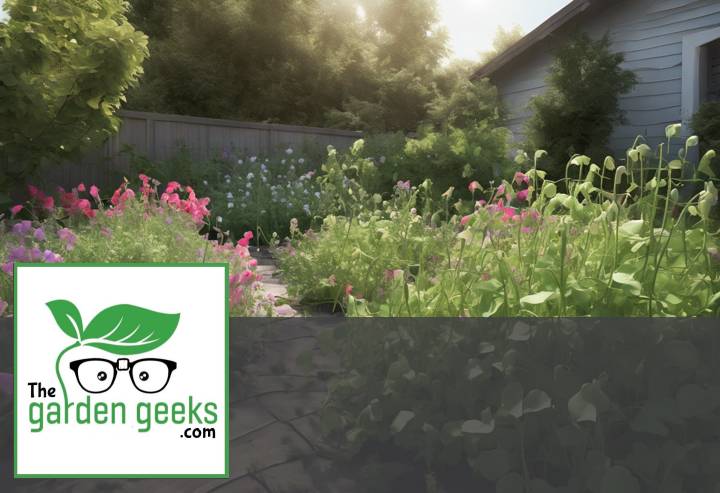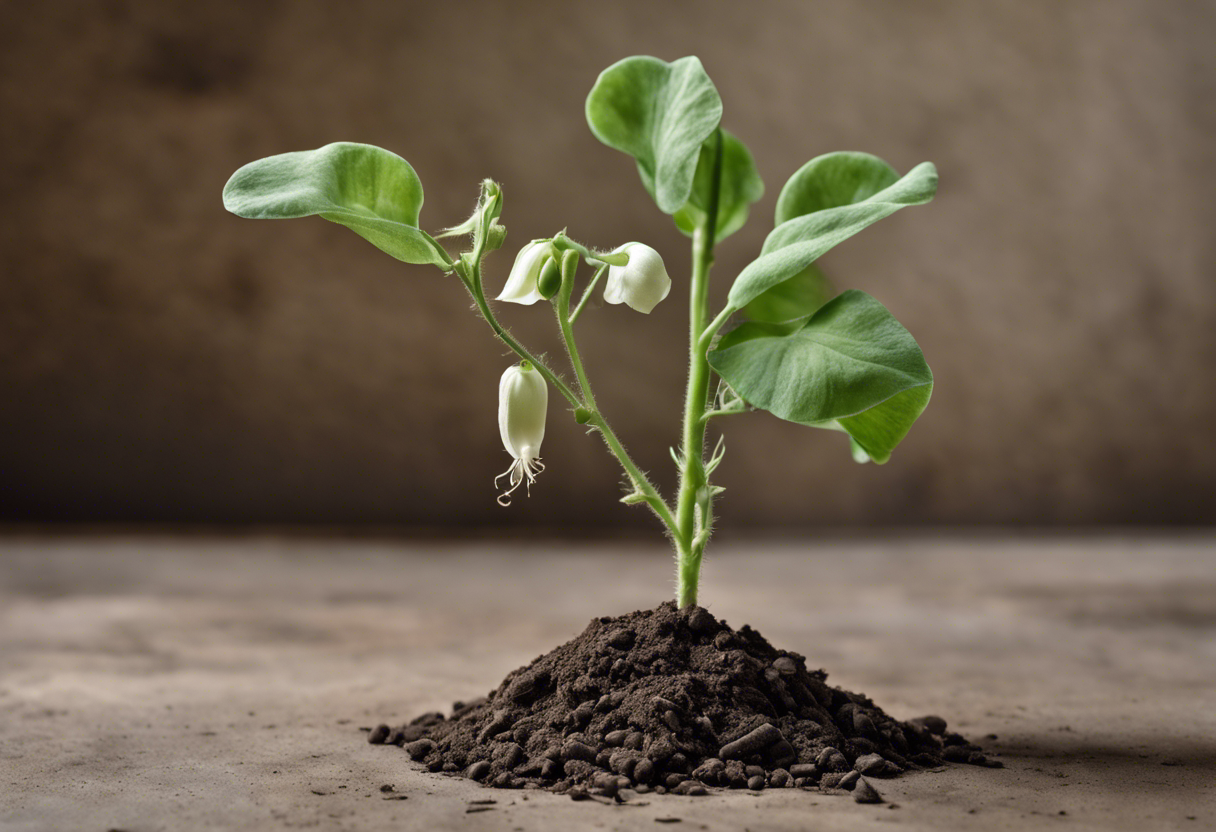Ever wondered Why Your Sweet Peas are not Blooming? Well, I did too! After spending countless hours tending to my sweet peas and waiting eagerly for those vibrant blooms, it was disheartening to see them remain bud-less.
But don’t fret! I’ve been down this road before and trust me, figuring out the reasons behind your sweet peas’ lack of bloom is not as complicated as it seems. Keep reading about (5 Reasons) Why Your Sweet Peas are not Blooming.
Key Takeaways
- Sweet peas may not bloom due to insufficient sunlight, as they require at least six hours of direct sun daily.
- Inadequate or excessive watering can also hinder blooming; sweet peas need well-drained soil and regular watering.
- Poor soil fertility, particularly lack of phosphorus, can prevent flowering. Regular fertilization with a high-phosphorus fertilizer is recommended.
- Pests or diseases may be affecting the plants’ health and ability to bloom.
- Overcrowding can limit growth and blooming; ensure enough space between plants for proper air circulation.
1. Insufficient Light
When it comes to why your sweet peas are not blooming, insufficient light could be the culprit. Sweet peas, like most plants, need a good amount of sunlight to thrive and bloom.
1.1 Understanding the Light Requirements of Sweet Peas
Sweet peas are full sun plants, meaning they require at least six hours of direct sunlight each day. They can tolerate partial shade but too much can hinder their growth and blooming process.
Photosynthesis in sweet peas is a crucial process that requires ample sunlight exposure. It’s what helps them transform light energy into chemical energy for growth and development.
1.2 Signs of Light Deprivation in Sweet Peas
If your sweet pea plant isn’t getting enough light, you’ll notice some clear signs. One common symptom is stunted growth in sweet peas.
Another sign is yellowing leaves – a classic indication of light deprivation symptoms in many plants, not just sweet peas.
Lastly, if your plant has become leggy or lacks blooms altogether, it’s likely craving more sunshine. So make sure you’re meeting the optimal sunlight needs for your sweet peas to keep them happy and blooming!
Inadequate Watering
Water, or lack thereof, can be a major culprit when it comes to why your sweet peas are not blooming. Proper watering is a key aspect of sweet pea care, and getting it wrong can leave you with a garden full of disappointment.
Ideal Watering Practices for Sweet Peas
So, how should you water your sweet peas? Well, the goal is to maintain consistent soil moisture. You don’t want the soil to dry out completely, but you also don’t want it soggy.
The watering frequency for sweet peas will depend on your climate and the time of year. Generally speaking, during hot weather, they may need watering daily.
Remember that optimal watering conditions also involve considering the time of day. Early morning or late evening is best as this reduces evaporation.
Symptoms of Overwatering and Underwatering
Now let’s talk about what happens when things go awry with watering. Overwatered plants often display yellow leaves – they’re literally drowning in too much love (and water).
Underwatered sweet peas, on the other hand, might have brown crispy edges on their leaves. They’re essentially crying out for a drink!
Recognizing these signs of plant stress from water issues can help you diagnose and fix any watering problems in your sweet pea patch before they become serious. So keep an eye out – your plants are counting on you!
Poor Soil Quality
Ever wondered why your sweet peas are not blooming? Well, it could be down to poor soil quality. The soil is the lifeblood of your garden, and when it’s not up to scratch, your sweet peas might just throw in the trowel.
Importance of Soil Quality for Blooming
You see, soil nutrients for sweet peas are like a five-star meal for these little green guys. They gobble up all that good stuff and use it to grow big and strong. But if the soil is lacking in nutrients, they’re left feeling a bit peckish. This can lead to nutrient deficiency in plants, which can seriously hamper their growth and blooming.
The importance of fertile soil cannot be overstated here. It’s like trying to run a marathon on an empty stomach – you’re not going to get very far! So if you want your sweet peas to bloom beautifully, you need to make sure they’re getting their fill of nutrients from the soil.
How to Improve Soil Quality for Sweet Peas
So how do we go about improving garden soil? Well, one way is through composting for sweet peas. Composting is like creating a gourmet meal for your plants – it’s packed full of nutrients and organic matter that will help improve the quality of your soil.
Another important factor is maintaining the right pH balance in gardening. Sweet peas prefer slightly acidic to neutral pH levels (6.0-7.5). If your soil is too alkaline or too acidic, it can prevent them from absorbing those vital nutrients.
Finally, don’t forget about adding nutrients directly into garden soil. Things like bone meal or well-rotted manure can give your sweet peas an extra boost and help them bloom beautifully. But remember folks – moderation is key! Too much of a good thing can also cause problems.
Incorrect Temperature Conditions
Sweet peas are a bit like Goldilocks, they need their conditions just right. Too hot or too cold and they’ll throw a tantrum by not blooming. Understanding sweet pea temperature requirements is crucial to keep them happy.
Optimal Temperature Range for Sweet Pea Growth
Sweet peas prefer a cool to moderate climate. The ideal temperature for sweet peas ranges between 55°F and 65°F during the day, and around 50°F at night. These are the best growing conditions for your sweet peas to thrive.
But remember, these plants are not fans of extreme temperatures. If you’re living in an area with scorching summers or freezing winters, you might have to put in extra effort for your sweet peas.
Impact of Extreme Temperatures on Blooming
Extreme temperatures can be quite a party pooper for your sweet peas’ blooming plans. High temperatures cause heat stress in plants, making it difficult for them to bloom.
On the flip side, extremely low temperatures can lead to cold damage to sweet peas, which again hampers their blooming process. So if you’re wondering ‘Why Your Sweet Peas are not Blooming‘, check your thermometer! It might just hold the answer you’re looking for.
5. Pest or Disease Infestation
Well, ain’t this a pickle? Why Your Sweet Peas are not Blooming could be down to some pesky critters or nasty diseases. Let’s get into the nitty-gritty of these sweet pea pests and disease infestations, and how they can put a damper on your blooming beauties.
5.1 Common Pests and Diseases Affecting Sweet Peas
First off, let’s talk about those tiny terrors known as aphids. These green or black insects love to suck the life out of your sweet peas, literally! They’re one of the most common aphids on sweet peas you’ll encounter.
Next up is Fusarium wilt, a fungal disease that causes yellowing leaves and wilting stems. It’s like the flu for plants! And then there’s powdery mildew, another fungus that coats your sweet peas in a white, powdery substance. Not exactly what you want in your garden!
Root rot is another culprit that might be messing with your blooms. This disease attacks the roots of your sweet peas causing them to decay and eventually die off. Finally, watch out for thrips damage; these tiny insects can cause significant harm to your plants by feeding on their sap.
5.2 Prevention and Treatment Methods
So how do we combat these invaders? Well, preventing aphids on sweet peas can be as simple as introducing beneficial insects like ladybugs into your garden.
For treating Fusarium wilt, it’s all about good hygiene practices – clean tools and regular crop rotation can help keep this fungus at bay. When it comes to controlling powdery mildew, fungicides are often effective but remember prevention is better than cure!
If you’ve got root rot in sweet peas, improving drainage and avoiding overwatering are key root rot treatment methods. And for those pesky thrips, insecticidal soaps or oils can be effective thrips control measures.
Remember folks, a healthy plant is a happy plant! Keep these tips in mind and you’ll have blooming sweet peas in no time.
To Wrap Up
Well, folks, that’s the long and short of why your sweet peas might be acting like rebellious teenagers refusing to bloom. From soil woes to pesky pests, we’ve walked you through the common culprits. Remember, gardening is like a dance – it takes two to tango!
So don’t give up on your floral companions just yet! With a bit of TLC and patience, you’ll have them blooming in no time. For more tips and tricks on Why Your Sweet Peas are not Blooming, keep digging around our blog. Happy gardening!





